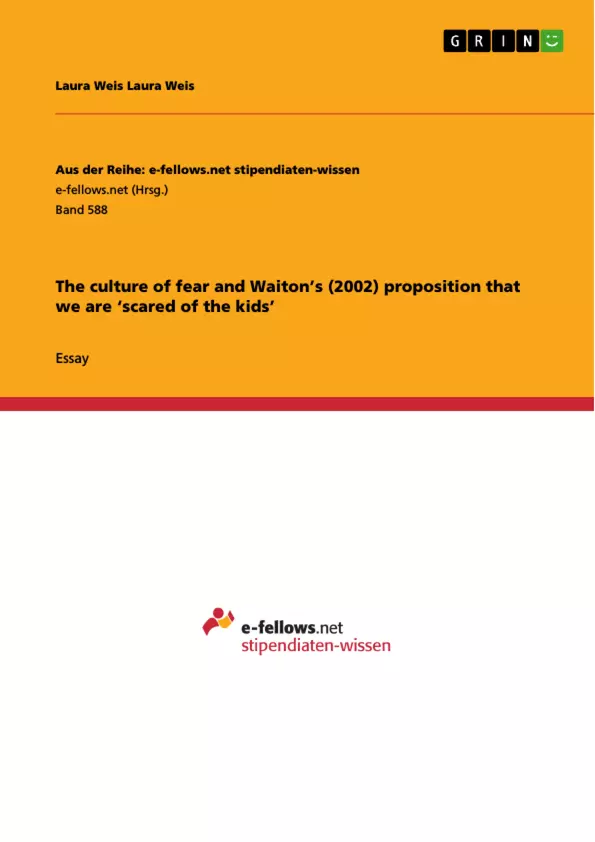Historically, public discourses have used the threats young people appear to pose, as a barometer of social ills and an indicator of society's moral decline (Brannen et al. 1994). Particularly nowadays this tendency is reflected in the increasing ‘evidence’ issued, fuelling public fear and neo-liberal policy reaction (Côté 2002).
Inhaltsverzeichnis (Table of Contents)
- The Culture of Fear
- Ephebiphobia: The Fear of Young People
- Institutionalized Mistrust
- The Social Construction of Crime and Fear
- The Effects of Fear on Children and Young People
- The Overprotection of Children
- The Price of Security: Freedom and Risk
- Rethinking the Dynamic Between Freedom and Security
Zielsetzung und Themenschwerpunkte (Objectives and Key Themes)
This text aims to explore the cultural and societal effects of fear and risk consciousness on young people and the relationship between generations. It critically examines how perceptions of young people as vulnerable and threatening contribute to a “culture of fear” and its consequences for their lives. * **The Culture of Fear:** The text analyzes the rise of a "culture of fear" in contemporary society, particularly focusing on the fear of young people. * **Ephebiphobia:** It delves into the concept of ephebiphobia, an irrational fear or hatred of young people, often fueled by media representations. * **Institutionalized Mistrust:** The text investigates the role of institutionalized mistrust and risk-averse policies in shaping the relationship between adults and young people. * **Social Construction of Crime and Fear:** It explores how crime and fear are often socially constructed, with certain groups being disproportionately targeted. * **Effects of Fear on Young People:** The text examines the negative consequences of a "culture of fear" on the lives of young people, including overprotection, limited freedom, and a sense of mistrust.Zusammenfassung der Kapitel (Chapter Summaries)
The Culture of Fear
This chapter introduces the concept of a "culture of fear" and how it is fueled by media representations, political discourse, and societal anxieties. It explores how fear has become a dominant perspective in contemporary society, influencing social interactions and shaping identities.Ephebiphobia: The Fear of Young People
This chapter examines the phenomenon of ephebiphobia, focusing on the irrational fear and hatred directed toward young people. It analyzes how this fear is often amplified by media portrayals and contributes to a negative perception of youth.Institutionalized Mistrust
This chapter explores how societal anxieties and risk consciousness have led to a growing mistrust between generations. It examines how this mistrust is institutionalized through policies and practices that aim to protect adults from perceived dangers posed by young people.The Social Construction of Crime and Fear
This chapter delves into the social construction of crime and fear. It argues that crime statistics are often partial and manipulated, and that fear is often deliberately used to gain political power or social dominance.The Effects of Fear on Children and Young People
This chapter discusses the detrimental effects of a "culture of fear" on children and young people. It examines how overprotection, surveillance, and limited freedom restrict their development and hinder their ability to take risks and learn from mistakes.The Overprotection of Children
This chapter explores the consequences of overprotection, arguing that it can create a false sense of vulnerability in children and limit their experiences and opportunities for growth.The Price of Security: Freedom and Risk
This chapter reflects on the trade-offs between security and freedom in a risk-conscious society. It highlights the potential for a "culture of fear" to erode individual liberties and create a climate of suspicion and distrust.Rethinking the Dynamic Between Freedom and Security
This chapter concludes by calling for a re-evaluation of the relationship between freedom and security. It suggests that promoting trust, fostering intergenerational dialogue, and embracing uncertainty are essential for creating a more balanced and healthy society.Schlüsselwörter (Keywords)
This text focuses on the key themes of fear, risk consciousness, ephebiphobia, institutionalized mistrust, social construction of crime, overprotection, and the relationship between generations. These themes are explored through the lens of contemporary society and its impact on children and young people.
Final del extracto de 6 páginas
- subir
- Citar trabajo
- Laura Weis Laura Weis (Autor), 2011, The culture of fear and Waiton’s (2002) proposition that we are ‘scared of the kids’, Múnich, GRIN Verlag, https://www.grin.com/document/205920
Leer eBook



